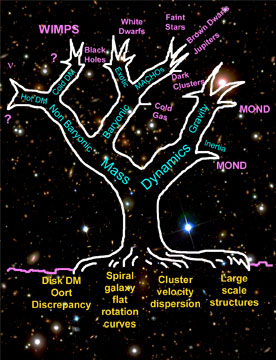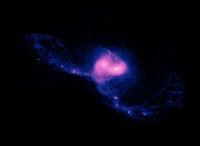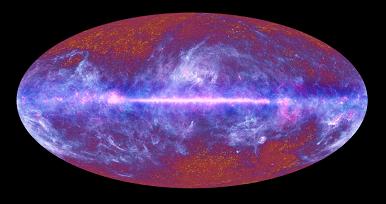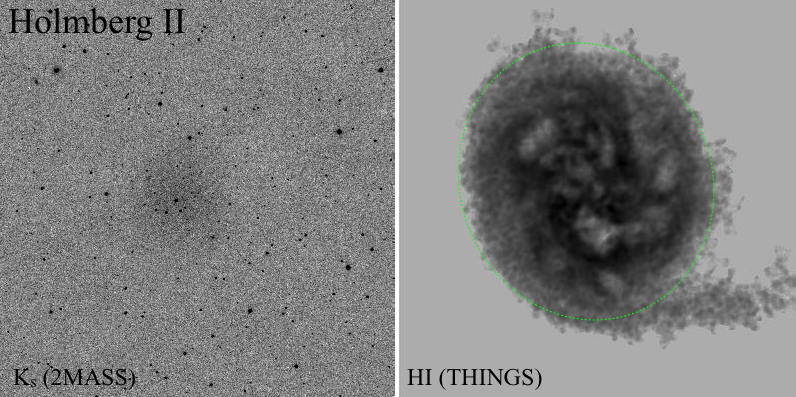

Welcome to the MOND pages
The Modified Newtonian Dynamics (MOND) s a scientific theory proposed by Moti Milgrom as a solution to the missing mass problem in extragalactic astronomy. Rather than invoking some invisible form of dark matter, it hypothesizes a subtle change to the effective force law at extremely low accelerations (< 10-10 m/s/s).
| New and stirring things are belittled because if they are not belittled, the humiliating question arises, 'Why then are you not taking part in them?' |
| - H. G. Wells |
- The basic issue, in brief, and
what's at stake.
- The Dark Matter Tree - a fanciful representation of the mass discrepancy problem.
- Why consider MOND?
- The Dark Matter Tree - a fanciful representation of the mass discrepancy problem.
| The normal component [i.e. the accepted paradigm and its adherents] is large and well entrenched. Hence, a change of the normal component is very noticeable. So is the resistance of the normal component to change. This resistance becomes especially strong and noticeable in periods where a change seems to be imminent. |
| Paul Feyerabend (1970) in Criticism and Growth of Knowledge, ed. I. Lakatos and A. Musgrave |
| A single galaxy might seem a little thing to those who consider only the immeasurable vastness of the universe, and not the minute precision to which all things therein are shaped. | 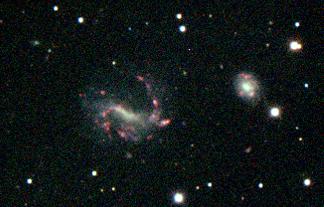 |
| Paraphrased from the Ainulindalë | by J.R.R. Tolkein. |
- MOND in the News
- See the press quotes page or this older link
- Blogs
- Dark Matter Crisis (Kroupa)
- Triton Station (McGaugh)
- Videos
- PBS Space Time: What if Our Understanding of Gravity is Wrong?
- Mark Huisjes's MOND video playlist
- Milgrom's youtube video links
- Sabine Hossenfelder asks is dark matter real?
- Mark Huisjes's MOND video playlist
- Scientific Literature
- Extensive list of the literature concerning
MOND, complete with links to the actual papers when available,
and the occassional commentary.
Note: ADS has become so good that I find I use it in preference to this list, so I no longer update it. - Scientific Reviews
- MOND Review by Milgrom on scholarpedia.
- MOND Laws: arXiv | MNRAS.
- Milgromian gravity review by Banik & Zhao.
- Predictions roundup of a priori predictions that have subsequently been corroborated.
- Mutual Incommensurability comparing [and not comparing] ΛCDM and MOND.
- Extensive review by Famaey, including observational phenomenology, challenges to ΛCDM, and some proposed relativistic extentions.
- Foundational Annual Review by Sanders.
- List of claims to falisify MOND and their rebutals compiled by Srikanth Nagesh.
- Philosophical Implications
- Sure to provide fodder for philosophers, sociologists and historians of science for decades to come.*
- A Philosophical Approach to MOND, a prize-winning book by David Merritt.
- Cosmology and Convention by David Merritt. Also available here.
- Philosophical aspects of the debate over Dark Matter and MOND.
- * I first wrote "decades to come" here in the 1990s, so this is now coming true.
- Frequently Asked Questions
- FAQ list.
- A comparison of how ΛCDM and MOND fare in various observational tests.
- The MOND procedure in a nutshell
- The External Field Effect in MOND and its explanation, with a note on modified inertia theories.
- Some musings by Milgrom on higher order predictions of MOND beyond its basic tenets.
- Some remarks on intellectual honesty and cognitive dissonance | The Blind Men and the Garden.
- Insightful article on the difficulty of objectivity, even in science.
- Material concerning Dark Matter
- Experimental Searches for dark matter - a perpetual quest?
Flowcharts: the dark matter flowchart (c. 1986) | the data interpretation flowchart (2012)
- Debates
- Debate with Pavel Kroupa & Simon White, 11/18/2010 Bethe Colloquium, Bonn University, Germany.
- Also available at this local link.
- Debate via email with Rainer Plaga & Sean Carroll, March 2011.
- Debate on Youtube with Simon White and Phil Halper, 1/5/2024.
- See also blog commentary.
- Also available at this local link.
- Public Talks and Related Material
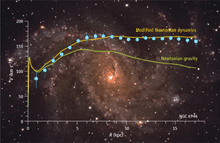
- Slides from a talk for the Crawley Astronomical Society (March 2021); also on Youtube.
- Golden Webinar, Pontificia Universidad Catolica de Chile (January 2021).
- Slides and audio from talk for the Cleveland Astronomical Society (December 2017).
- Benson Memorial Lecture: slides and audio (April 2016).
- Public Talk for the Toledo Astronomical Association (March 2015). This talk can be seen on Youtube.
- A popular perspective: Gravity for All Scales | [PDF] written for Astronomy Now (January 2002).
- Milgrom's article for Scientific American (August 2002)
- There have been a number of other good, popular level reviews - see the literature page.
- Video presentation by Stacy McGaugh (in English).
- Video presentation by Benoit Famaey (in French).
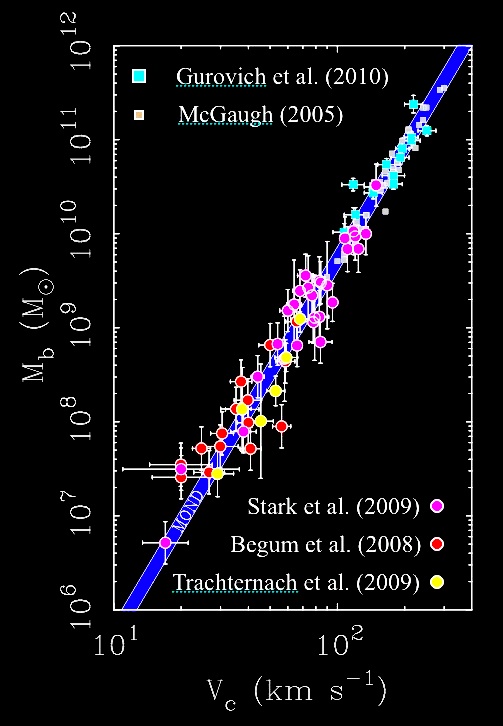
- Slides from a few Science talks related to MOND
- Colloquium given at George Washington University emphasizing the external field effect, March 2021
- Colloquium given at DTM, May 2016
- MOND overview for the Carnegie Cognitive Astrophysics workshop, March 2014
- Skype talk for the dark matter seminar at the University of Arizona, March 2012
- Review talk for Modifed Gravity Approaches to the Dark Sector, June 2010
- Colloquium given at DTM, April 2008
- Colloquium given at TRIUMF, February 2008
- Physics department colloquium given at George Mason University, April 2007.
- Review talk given at the Alternative Gravities and Dark Matter Workshop, April 2006.
- Physics department colloquium given at the University of Rochester, April 2006.
- Review talk given at the interdisciplinary conference Dark Matter in the Universe, October 2005.
- Material related to the Dynamical Evidence
- Comparison of MOND and Dark Matter | New table (11/2011)
- Public Talks and Related Material
- Includes a table itemizing various observational tests and how each fares.
- Example of a MOND fit to a rotation curve.
- Comparison of MOND and CDM fits to the rotation curve of NGC 1560.
- Lots and lots of fits (2003).
- Comparison of MOND and CDM fits to the rotation curve of NGC 1560.
- These are plotted log(V)-log(R) for data with velocity errors < 5%.
- Points with error bars are the data; red lines are the fits; light blue lines are the Newtoinian stars+gas.
- Residuals of MOND fits (3/2012)
- Predictions made by Milgrom in 1983 which were subsequently confirmed (in 1998 and again in 2011)
- A MOND fit to the rotation curve of a low surface brightness galaxy.
- Mass-to-Light Ratios and Stellar Populations
- Predictions made by Milgrom in 1983 which were subsequently confirmed (in 1998 and again in 2011)
- Remarkably reasonable.
- Roster of galaxies which have been used to test MOND:
- 84-0-11
- MOND performs well in the Milky Way,
providing detailed information about the surface density profile.
- N-body computations
- Modelers beware: implementing MOND is not a one line change to
standard particle-pushing codes.
Chris Mihos
explains why. (The inertial modification is inherently nonlocal.)
[See also a more sober write-up.]
- Other numerical approaches are necessary. For example, Brada's thesis; Ciotti, Londrillo, & Nipoti; Tiret & Combes.
- Other numerical approaches are necessary. For example, Brada's thesis; Ciotti, Londrillo, & Nipoti; Tiret & Combes.
- Big Bang Nucleosynthesis and the Baryon Density
- BBN: Comparison of the
density of
baryons in ΛCDM & MOND.
- The Missing Baryon Problem goes away in MOND.
- The Missing Baryon Problem goes away in MOND.
- Large Scale Structure
- An outline of the
formation of large scale structure in MOND.
- Material related to the Cosmic Microwave Background
- The CMB is widely perceived to be a problem for MOND, but this is (at best)
an overstatement. The amplitude ratio of the first-to-second peak of the
acoustic power spectrum was predicted in advance by
McGaugh (1999)
with a MOND-motivated model. This prediction remains bang-on in the WMAP
data, so I would be more sympathetic to assertions about the CMB had that
community been more honest in acknowledging this successful prediction.
(They would have burst at the seems with excitement if a similarly accurate
prediction had been made conventionally. I also made such a
conventional prediction in 1999, but that wasn't the one that worked).
Instead, my prediction was widely ignored until the third peak was measured.
That does not agree with the prediction of the model I presented
in 1999, a fact that cosmologists are much more eager to acknowledge.
The amplitude of the third peak observed by WMAP merely
falsifies the simple ansatz I used to make the prediction, not MOND itself.
Indeed, I pointed out in the original papers that the ansatz must fail at
some level, so I am hardly surprised that it does. All this means is that
there are degrees of freedom (like a scalar field) that can oscillate
separately from baryons in whatever the relavistic parent theory of MOND
might turn out to be.
The real test was for ΛCDM: the third peak had to be higher than predicted by pure baryonic damping. ΛCDM survives this test. It "wins ugly" in that, in order to obtain a fit, we have had to nearly double the baryon density over what it was so confidently known to be before it wasn't. That, and the no-CDM prediction for the second peak is still bang on. Amazing coincidence, that. - Comments on specific events in chronological order
- 1999: No-CDM model provides best-guess prediction for CMB in a MOND universe.
- Strictly speaking, only the shape of the power spectrum is predicted in the absence of CDM. This represents MOND only under the ansatz that a MOND version of GR is identical to standard GR in the early universe. More properly, this is a test for the existence of non-baryonic dark matter, and says nothing directly about MOND.
- 2000:
No-CDM prediction realized in
BOOMERanG microwave background data.
- 2001: How the No-CDM prediction fares with DASI and updated (in May, 2001) BOOMERanG CMB data.
- 2003: No-CDM & WMAP (Feb. 2003).
- 2001: How the No-CDM prediction fares with DASI and updated (in May, 2001) BOOMERanG CMB data.
- WMAP 1st:2nd peak amplitude ratio bang on the No-CDM prediction.
- WMAP polarization detection confirms the prediction of early reionization.
- The critical third peak remains ill-constrained.
- WMAP polarization detection confirms the prediction of early reionization.
- 2004: The WMAP second-year data are late.
- 2005: BOOMERanG reports new data from its 2003 Antarctic flight (Aug. 2005).
- The WMAP second-year data are a year and half late and counting...
- 2006: WMAP finally reports new data (March 2006).
- The systematic uncertainties concerning the third peak are really daunting. We need to know the point spread function incredibly well. It is not obvious that there can be no instrumental non-linearities that might make the PSF for faint sources differ from that of the bright calibration source (Jupiter).
- 2006:
The Third Peak in TeVeS (April 2006).
- 2013: Planck reports on the power spectrum.
- As expected, Planck provides a much improved version of the CMB acoustic power spectrum.
All peaks are now clearly visible. The 1:2 peak ratio remains exactly as predicted by
McGaugh (1999) while the
third peak is clearly higher than it would be in a purely baryonic damping spectrum.
- The net upshot: nothing new.
- ΛCDM provides an excellent fit to the improved CMB data just as MOND provides an excellent fit to improved rotation curve data. As before, one's interpretation depends entriely upon which you find more impressive.
- The net upshot: nothing new.
- 2020:
The third peak is well-fit in AeST.
- 2023: The Hubble Tension appears to be driven by a systematic in CMB fits rather than an error in local measurements.
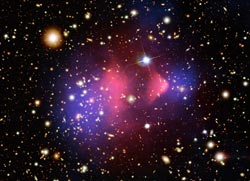
- Material related to the Bullet Cluster
- The bullet cluster has become the most cited piece of evidence against MOND.
- 2023: The Hubble Tension appears to be driven by a systematic in CMB fits rather than an error in local measurements.
- The problem is that, even after consideration of MOND, there remains an
unexplained mass discrepancy. This is generally the case in rich clusters,
the bullet cluster merely shows the general effect in spectacular fashion.
However, there is no evidence that requires the unseen mass to be the
non-baryonic cold dark matter required by cosmology. While it is certainly
unpleasant to invoke dark baryons, it appears to be unavoidable in both
ΛCDM and MOND.
- It is always unwise to over-interpret a single object, especially when aspects of that object are also problematic for ΛCDM: the collision speed makes a lot more sense in the context of MOND. That doesn't mean we can't understand it in ΛCDM, but then the same holds for MOND.
- It is always unwise to over-interpret a single object, especially when aspects of that object are also problematic for ΛCDM: the collision speed makes a lot more sense in the context of MOND. That doesn't mean we can't understand it in ΛCDM, but then the same holds for MOND.
- In general, even if we consider the bullet cluster to falisfy MOND,
it does not relieve us of understanding the observed phenomenology in galaxies.
- Comments on the Bullet Cluster claim to require dark matter.
- The full text of
my reply to press inquiries (from which published quotes were extracted).
- Paper by Angus et al. fitting the new data.
- Preprint examining the collision velocity of the clusters. This is more naturally understood in terms of MOND than CDM. [Published in MNRAS (2008) 383, 417]
- The bullet cluster is also a problem for ΛCDM.
- Milgrom's comments on the Bullet Cluster
- An unsolicited, independent perspective
- Related talks by Angus: PPT | text
- Paper by Angus et al. fitting the new data.
- The collision velocity of
the bullet cluster in CDM and MOND.
- A counter-example to the bullet cluster - Abell 520.
- The dark matter ring in cluster 0024+17.

- Material related to Tidal Dwarfs
- A counter-example to the bullet cluster - Abell 520.
- Can tidal dwarfs falsify dark matter?
- Or prove its existence by its absence?
- Or prove its existence by its absence?
- Criticisms
- MOND is an idea people love to hate.
They already know dark matter is right, so MOND must be crazy talk:
no need to consider the evidence! Often they seek to kill the messenger,
because this is a cosmic heresy of the tie-'em-to-a-stake and light-'em-up variety.
Renzo Sancisi realized this early (c. 2000) when he pointed out
the statue of Giodarno Bruno to me in Rome.
- Courage is not the absence of fear, but rather the judgement that something else is more important than fear.
- - Ambrose Redmoon (James Neil Hollingworth)
- Some remarks on intellectual honesty and cognitive dissonance.
- Not everyone holds a high standard of intellectual honesty.
Here is a simple test to distinguish true scientists
from wannabes.
- Fan mail from both sides illustrating how ridiculous attitudes can get:
- Bad scientist! from a dark matter advocate.
- Bad scientist! from a MOND advocate.
- Bad scientist! from a MOND advocate.
- The sociology of modern cosmology has a disturbing amount in common with the Inquisition in the time of Galileo. To paraphrase the Pope's censor,
- It is OK to consider [heliocentrism/MOND]
as an abstract hypothesis that is convenient for making certain astronomical
computations. But don't dare to suggest it might have something to do with
reality.
- Comments on the sociology surrounding
the early 2013 controversy about the temporary closing of the
Dark
Matter Crisis.
- Fortunately, sometimes I do get an encouraging word.
- Rebuttal of criticisms made by Foreman & Scott
- Fortunately, sometimes I do get an encouraging word.
- Note: I have no intention of submitting my rebuttal to a journal.
The nonsense by Forman & Scott has no business being published in a
refereed journal, and stuff that happens on
arxiv should stay on
arxiv.
MOND - dark matter - modified newtonain dynamics
MOND - dark matter - modified newtonain dynamics
MOND - dark matter - modified newtonain dynamics
MOND - dark matter - modified newtonain dynamics

MOND - dark matter - modified newtonain dynamics
MOND - dark matter - Modified Newtonain Dynamics
MOND - dark matter - modified newtonain dynamics
